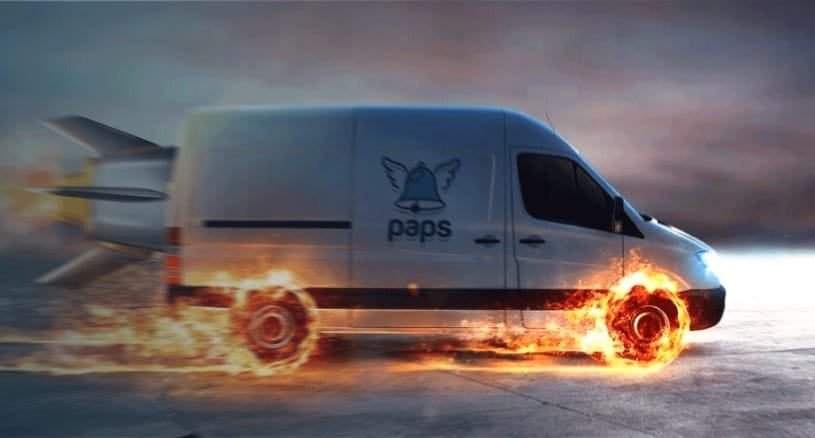TL;DR
- Challenge: Fulcrum (3rd-party tool) was expensive, unfit for Paps’ real operations, and a poor user fit.
- Goal: Build a custom MVP to replace Fulcrum, reduce cost, and fit our operational needs.
- Solutions: Unified web app with role-based views + mobile app optimized for delivery.
- Results: -60% cost, +40% faster campaign setup, 85% adoption rate, +100% delivery success.
The Problem
Paps managed thousands of invoice deliveries every month using Fulcrum, a rigid and expensive tool. It created friction across all levels:
- Thousands of dollars in monthly license costs
- No visibility or control for customers
- Misaligned workflows for managers
- Bad mobile UX for delivery personnel
We needed a lean MVP to prove value, reduce costs, and unlock autonomy.

Research & Discovery
Methods
15 field observations with delivery teams
12 customer interviews (external)
8 sessions with distribution managers
6 interviews with operations/finance stakeholders
Competitive audit (Fulcrum, TaroWorks, FieldEZ)
Process mapping + integration requirement analysis
Personas & key pain points
Customers
"I can’t track anything in real time."
- Setup is complicated
- No live monitoring or clear analytics
Distribution Managers
"This tool wasn’t made for our job."
- Rigid workflows
- No integration with Paps systems
- Manual reconciliation overhead
Delivery Personnel
"I spend more time fighting the app than delivering."
- Confusing interface on mobile
- No feedback/reporting tools
Critical Insights
Wrong fit
Fulcrum was built for data collection, not logistics.
Hidden costs
Time spent on workarounds and support calls added up.
Scalability barrier
Couldn’t support growth or future operational needs.
Empowerment gap
Users lacked autonomy and fluidity in daily operations.
Design Strategy
How Might We…
...Build a distribution tool tailored to Paps’ operations?
...Empower each stakeholder with relevant tools?
...Cut dependency on rigid third-party systems?
...Ensure future scalability + easy integrations?
Principles
- Operational efficiency: streamline workflows for speed and clarity
- Contextual intelligence: show what matters, when it matters
- Scalable flexibility: support diverse campaign formats
- Offline resilience: full functionality in low-connectivity zones
Product Strategy
We focused on 3 user value pillars:
- Customers: Campaign control + live visibility
- Ops teams: Workflow alignment + performance reporting
- Delivery staff: Speed, clarity
Design Process
Journey mapping
We mapped the full distribution lifecycle for each stakeholder:
Prioritization (value/Effort)
MVP (High Value, Low Effort):
- Campaign creation flow
- Real-time dashboard
- Optimized mobile UI
Phase 2 (High Value, High Effort):
- Advanced analytics
- External logistics integrations
Information Architecture
3 main interaction layers:
Web: campaign management
setup, monitor, report
Web/Mobile: operational oversight
resources, issues
Mobile: field execution
routes, delivery data, issues
Prototyping & Testing
- Wireframes built around role-specific needs
- Progressive disclosure to reduce interface overload
- Mobile-first layout for delivery app
92% task completion rate accross 12 users tested
Solutions Designed
1. Unified web app (role-based ui)
Goal: Replace Fulcrum with a centralized platform, split by user role.
Customer View:
- Step-by-step campaign builder
- Real-time tracking dashboard
- Exportable data for BI
Ops Manager View:
- Resource allocation tools
- Exception alerts
- System-wide performance metrics
Design Choices:
- Shared core UI components (faster dev)
- Role-based feature toggles
- Mobile-responsive architecture
2. Mobile Delivery App
Goal: Make field execution seamless, even with low internet.
Features:
- Route optimization with map
- Full offline capabilities
- Delivery info (context, contact, notes)
- Issue reporting (photos + notes)
Design Choices:
- Large touch targets, high contrast
- Smart sync logic
- Voice-guided navigation
Documentation & Enablement
- Created video + written documentation
- Led internal training sessions with all delivery + ops teams
- Documented logic and edge cases for dev handoff
Results & Business Impact
(license savings)
(2 days → 1.2 avg)
(target: 70%)
(better routing & data)
Business impact:
- Opened 3 new regions with same ops staff
- Laid foundations for new B2B logistics services
- Boosted customer satisfaction scores
Learnings & Next Steps
What I’d Improve
- Earlier tech validation with devs
- Phased rollout for smoother adoption
- Anticipating BI/reporting needs earlier
What Worked
- Field immersion: better design than interviews alone
- Iterative validation: no major redesigns
- Cross-team collaboration: faster rollout, better buy-in
What’s Next
- Deeper integration with core logistics systems
- Analytics suite (operational intelligence)
- B2B partner features for logistics as a service
reflection
This project has taught me some valuable lessons. I learned the importance of transparent communication, flexibility, emotion management and adaptability. The key breakthrough came from recognizing that we weren’t just replacing a tool, we were redesigning a critical business process. This required balancing user experience with operational efficiency, cost considerations, and scalability requirements.
In addition, I had the opportunity to immerse myself in the world of product management, working closely with managers to define product objectives, establish a roadmap and manage priorities.
This experience strengthened my leadership and team management skills, while underlining the importance of collaboration between design and product management.























